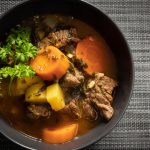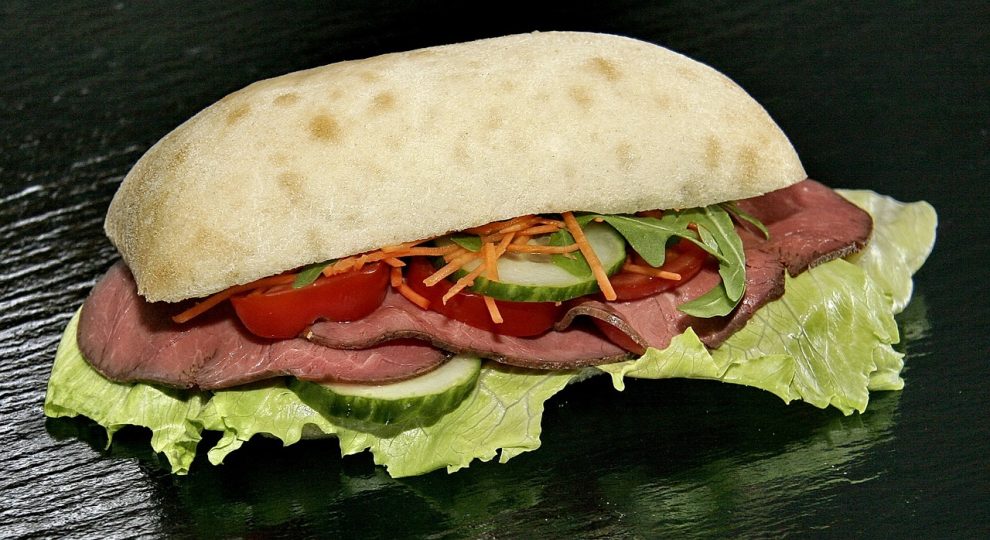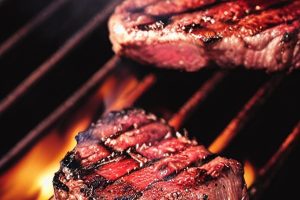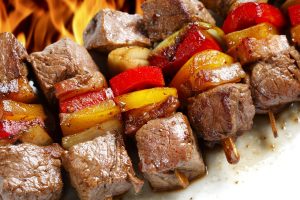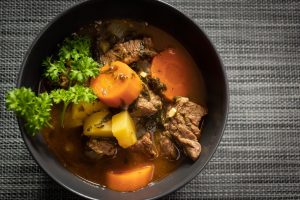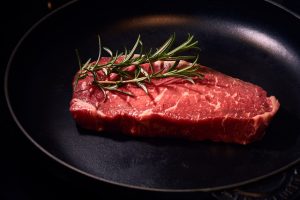Unraveling the Origins of Mushu Beef: A Culinary Journey through Ancient China
Mushu beef, a beloved dish in Chinese cuisine, has a rich and intriguing history that spans centuries. This culinary delicacy, known for its tender beef, fragrant spices, and delicate wrapping, has become a staple in Chinese restaurants worldwide. However, to truly appreciate the origins of mushu beef, one must embark on a culinary journey through ancient China.
The roots of mushu beef can be traced back to the Northern and Southern dynasties of China, which lasted from the 4th to the 6th century. During this time, the Chinese people developed a taste for finely sliced and marinated beef, which they would wrap in thin pancakes made from wheat flour. These pancakes were not only a practical way to hold the beef, but they also added a delightful texture to the dish.
As time went on, mushu beef evolved and gained popularity during the Tang dynasty (618-907 AD). This period marked a golden age for Chinese cuisine, with an emphasis on refined cooking techniques and elaborate flavors. Mushu beef became a favorite among the imperial court and the upper classes, who relished its intricate preparation and delectable taste.
The art of making mushu beef was further refined during the Song dynasty (960-1279 AD). Influenced by Confucian ideals, the Chinese people sought balance and harmony in all aspects of life, including food. Mushu beef was prepared with great precision and attention to detail, with each ingredient carefully selected and prepared to create a harmonious blend of flavors.
The popularity of mushu beef continued to grow during the Ming dynasty (1368-1644 AD). This era saw the rise of the merchant class, who brought prosperity and cultural exchanges to China. As a result, mushu beef spread beyond the imperial court and became a popular street food enjoyed by people from all walks of life.
In modern times, mushu beef has become a staple in Chinese cuisine, both in China and around the world. Its popularity can be attributed to its versatility, as it can be enjoyed as a main dish or as part of a larger meal. The delicate balance of flavors, combined with the tender beef and crispy pancakes, continues to captivate the palates of diners everywhere.
In conclusion, the origins of mushu beef can be traced back to ancient China, where it was enjoyed by the elite and commoners alike. Its evolution over the centuries reflects the changing tastes and cultural influences of Chinese society. Today, mushu beef remains a testament to the rich culinary heritage of China, and its enduring popularity is a testament to its exquisite taste and timeless appeal.
From Ancient Recipes to Modern Delights: Tracing the History of Mushu Beef
Mushu beef is a popular Chinese dish that has a long and fascinating history. From its origins in ancient recipes to its modern adaptations, this dish has delighted taste buds for centuries. In this article, we will trace the history of mushu beef, exploring how it has evolved over time.
The earliest mentions of mushu beef can be found in ancient Chinese texts, dating back to the Han Dynasty (206 BC – 220 AD). These texts describe a dish called “mushu pork,” which consisted of thinly sliced pork cooked with mushrooms and other vegetables. The name “mushu” translates to “wood shavings,” referring to the thin slices of meat used in the dish.
Over the centuries, mushu pork evolved and adapted to regional tastes and ingredients. During the Tang Dynasty (618-907 AD), the dish began to incorporate beef, giving birth to mushu beef. This variation became particularly popular in northern China, where beef was more readily available than pork.
The cooking technique for mushu beef also underwent changes throughout its history. In ancient times, the meat was stir-fried in a wok over high heat, giving it a smoky and charred flavor. Eventually, the dish started to be prepared using a hotplate or griddle, which allowed for better control of the cooking process.
During the Ming Dynasty (1368-1644 AD), mushu beef gained further popularity and was served in the imperial courts. It was during this period that the dish acquired its characteristic thin pancakes, which are an essential part of the modern mushu beef experience. These pancakes were made by rolling out a simple wheat flour dough and cooking it on a flat griddle until it became soft and pliable.
In the modern era, mushu beef has become a staple in Chinese restaurants around the world. Chefs have continued to innovate and experiment with the dish, incorporating new ingredients and flavors. Some variations include adding additional vegetables like bell peppers and bamboo shoots, or even substituting the traditional pancakes with tortillas or crepes.
In conclusion, mushu beef has a rich and diverse history that spans centuries. From its humble origins in ancient recipes to its modern adaptations, this dish has evolved to become a favorite among Chinese food enthusiasts. Whether enjoyed in its traditional form or with a contemporary twist, mushu beef continues to be a delightful culinary experience that showcases the skill and creativity of Chinese cuisine.
The Rise of Mushu Beef: Exploring its Historical Roots in Chinese Cuisine
The Rise of Mushu Beef: Exploring its Historical Roots in Chinese Cuisine
Chinese cuisine is renowned for its rich history and diverse range of flavors. From the delicate flavors of Cantonese cuisine to the spicy dishes of Sichuan, each region of China has contributed unique dishes to the culinary world. One such dish that has gained popularity in recent years is Mushu Beef. This article will delve into the historical roots of Mushu Beef and shed light on its rise to prominence in Chinese cuisine.
Mushu Beef, also known as Moo Shu Beef, is a traditional Chinese dish that originated in Northern China. It is believed to have been created during the Tang Dynasty (618-907 AD), a period known for its flourishing arts and culture. The dish was initially prepared using thinly sliced beef, which was stir-fried with a variety of vegetables such as mushrooms, cabbage, and bamboo shoots.
The name “Mushu” is derived from the Chinese term “mou shu,” which means “wood shavings.” This name was given to the dish due to its characteristic thin and shredded appearance. Mushu Beef was traditionally served with Mandarin pancakes, which were used to wrap the meat and vegetables, much like a burrito. These pancakes provided a soft and delicate texture that complemented the flavorful filling.
Over time, Mushu Beef gained popularity among both the upper and lower classes in China. It was celebrated for its versatility, as it could be enjoyed as a main course or as a filling for dumplings. The dish was often served during special occasions and festivals, becoming a staple in Chinese banquet cuisine.
The rise of Mushu Beef in Chinese cuisine can be attributed to several factors. Firstly, the dish’s versatility and adaptability made it an ideal candidate for fusion with other cuisines. As Chinese immigrants began to settle in different parts of the world, they brought their culinary traditions with them. Mushu Beef, with its flavorful combination of meat and vegetables, became a popular choice in Chinese-American cuisine.
Furthermore, the rise of tourism in China has also played a role in popularizing Mushu Beef. As more travelers from around the world visit China, they have been exposed to the diverse range of Chinese dishes. Many tourists have fallen in love with Mushu Beef’s unique flavors and have sought to recreate the dish in their home countries.
In recent years, Mushu Beef has undergone some variations to cater to different tastes and dietary preferences. Some modern adaptations include the addition of hoisin sauce, which provides a sweet and savory flavor, and the use of tortillas instead of traditional Mandarin pancakes. These adaptations have helped to further popularize Mushu Beef worldwide, making it a favorite among Chinese food enthusiasts.
In conclusion, Mushu Beef is a dish with a rich history and a promising future in Chinese cuisine. Its origins can be traced back to the Tang Dynasty, and it has since gained popularity among both the Chinese and international communities. As Chinese cuisine continues to evolve and adapt, Mushu Beef remains a beloved dish that showcases the diversity and creativity of Chinese culinary traditions.
Mushu Beef: A Delicious Fusion of Flavors Dating Back Centuries
Mushu beef is a delectable dish that brings together a fusion of flavors that have been enjoyed for centuries. This dish originates from China and has made its way to various parts of the world, captivating the taste buds of many with its rich and savory taste. In this article, we will delve into the origins of mushu beef, explore the ingredients that make up this delightful dish, and highlight the cooking techniques used to create its unique flavor profile.
Dating back to ancient China, mushu beef has been a staple in Chinese cuisine for generations. The dish is said to have originated during the Northern and Southern Dynasties period, which lasted from the 4th to the 6th century. It was traditionally prepared as a way to utilize leftover ingredients, making it a practical and resourceful meal. Over time, mushu beef gained popularity and evolved into a beloved dish that is now enjoyed in many Chinese households and restaurants worldwide.
The key ingredients that contribute to the distinct flavors of mushu beef are beef, typically thinly sliced, and a medley of vegetables such as mushrooms, cabbage, and carrots. These ingredients are combined with a savory sauce made from soy sauce, oyster sauce, and various spices. The result is a harmonious blend of flavors that complement the tender beef and crisp vegetables.
To create the perfect mushu beef, the cooking process involves several steps that require skill and precision. The beef is first marinated in a mixture of soy sauce, ginger, and garlic, allowing the flavors to infuse into the meat. It is then stir-fried in a hot wok until it reaches a tender and juicy consistency. The vegetables are separately cooked to retain their crunchiness and freshness. Finally, the beef and vegetables are combined, and the sauce is added to the wok, further enhancing the flavors of the dish.
The presentation of mushu beef is just as important as its taste. Traditionally, it is served with thin pancakes made from flour, which are used to wrap the beef and vegetables. This adds a delightful texture to each bite and allows for a hands-on dining experience. Additionally, condiments such as hoisin sauce and scallions are often served alongside mushu beef, adding an extra layer of flavor and freshness.
In conclusion, mushu beef is a mouthwatering fusion of flavors that has stood the test of time. Its origins can be traced back centuries, and it has become a beloved dish in Chinese cuisine. With its tender beef, crisp vegetables, and savory sauce, mushu beef offers a delightful balance of textures and flavors. Whether enjoyed in a traditional Chinese restaurant or in the comfort of your own home, mushu beef is sure to tantalize your taste buds and leave you craving more.
Unveiling the Secrets of Mushu Beef: How this Chinese Dish Evolved Over Time
Mushu beef, a popular Chinese dish, has a rich history that spans centuries. This culinary masterpiece has evolved over time, with various influences shaping its unique flavors and cooking techniques. In this article, we will delve into the secrets of Mushu beef, tracing its origins and exploring the factors that have contributed to its transformation.
Mushu beef traces its roots back to northern China, where it first emerged during the Tang Dynasty (618-907). Initially, the dish consisted of thinly sliced beef stir-fried with a medley of vegetables, such as mushrooms, bamboo shoots, and cabbage. These ingredients were then wrapped in a thin pancake made of wheat flour, creating a delightful combination of flavors and textures.
Over time, Mushu beef underwent a series of modifications as it spread across different regions of China. The Mongol invasion of the 13th century brought with it a significant change in the dish’s preparation. Mongolian influence introduced a new cooking technique known as “flash-frying,” which involved quickly searing the beef over high heat to retain its tenderness and juiciness. This method revolutionized the texture of Mushu beef, making it more succulent and flavorful.
Another pivotal moment in the evolution of Mushu beef occurred during the Ming Dynasty (1368-1644). The imperial court’s sophisticated taste and culinary preferences influenced the dish’s presentation and ingredients. The dish became more refined, with the addition of luxurious ingredients such as black truffles and abalone. This elevated version of Mushu beef was primarily served at royal banquets, becoming synonymous with opulence and extravagance.
During the Qing Dynasty (1644-1912), Mushu beef underwent further changes as it spread to the southern provinces of China. The southern regions introduced their own unique spin on the dish, incorporating local ingredients and cooking techniques. In Guangdong province, for example, Mushu beef was prepared with a sweet and tangy sauce, adding a distinct flavor profile to the dish. In Sichuan province, the dish was infused with fiery spices, giving it a bold and numbing sensation.
In recent years, Mushu beef has gained international recognition and popularity, appearing on menus in Chinese restaurants worldwide. However, it is essential to note that the dish’s preparation and flavors may vary depending on the region and the chef’s interpretation.
Today, Mushu beef remains a beloved Chinese dish, cherished for its harmonious blend of textures and flavors. Its evolution over time reflects the diverse cultural influences and culinary traditions that have shaped Chinese cuisine. Whether enjoyed in its traditional form or with a contemporary twist, Mushu beef continues to captivate food enthusiasts around the globe.
In conclusion, Mushu beef has a fascinating history that dates back centuries. From its humble beginnings in northern China to its modern-day interpretations, this dish has evolved, incorporating various ingredients and cooking techniques. Its enduring popularity is a testament to the timeless appeal of Chinese cuisine and its ability to adapt and innovate while retaining its distinctive flavors.



